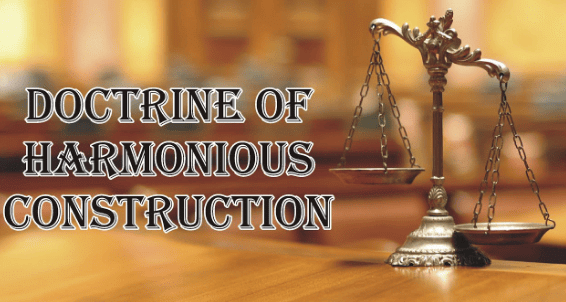Doctrine of Harmonious Construction - CLAT PDF Download
Introduction
When a legislative enactment is passed, it is essential to ensure that its text is clear and unambiguous. In situations where inconsistencies arise between two or more statutes or between sections within a statute, the Doctrine of Harmonious Construction is applied.

What is the Doctrine of Harmonious Construction?
The doctrine of harmonious construction refers to an interpretative approach aimed at achieving consistency and coherence among various provisions of an enactment.
- If a statutory provision is open to multiple interpretations, courts strive to adopt a meaning that ensures all provisions retain their significance and none become redundant or void.
Origin of the Doctrine of Harmonious Construction
This doctrine was first applied in the landmark case of Shankari Prasad v. Union of India (1951), during the interpretation of conflicts between Fundamental Rights and Directive Principles of State Policy (DPSP).
- The court harmonized the two by declaring them complementary aspects of governance, both serving the public good.
Principles Governing the Doctrine of Harmonious Construction
In Commissioner of Income Tax v. Hindustan Bulk Carrier (2003), the Supreme Court laid down key principles:
- Avoidance of Conflict: Courts must interpret provisions in a manner that avoids direct conflict.
- Mutual Consistency: No provision should render another provision ineffective unless unavoidable.
- Reconciliation of Conflicts: When reconciliation is challenging, courts should aim to give effect to both provisions.
- Rejection of Redundancy: An interpretation that nullifies or renders a provision ineffective is not acceptable.
- Preservation of Purpose: Harmonious construction ensures that no provision defeats another.
Applicability of the Doctrine of Harmonious Construction
Courts apply the doctrine using the following measures:
- Maximizing Effectiveness: Both provisions should be interpreted to reduce inconsistencies.
- Comprehensive Reading: Conflicting clauses are read in the context of the entire statute.
- Broader Scope: The provision with broader applicability takes precedence.
- Legislative Intent: Courts consider the legislature’s intent in enacting the provisions.
- Use of Non-Obstante Clauses: If one provision explicitly overrides another, courts follow the overriding clause.
Landmark Case Laws
Re Kerala Education Bill (1951):
The Supreme Court emphasized balancing Fundamental Rights and Directive Principles through harmonious interpretation, ensuring both are given due effect.East India Hotels Ltd. v. Union of India (2001):
The Court ruled that an Act must be read as a whole, with its provisions harmonized to ensure they all have legal effect.
By adopting the doctrine of harmonious construction, courts ensure that legislative provisions coexist without undermining each other, maintaining the coherence and purpose of the law.
FAQs on Doctrine of Harmonious Construction - CLAT
| 1. What is the Doctrine of Harmonious Construction? |  |
| 2. What is the origin of the Doctrine of Harmonious Construction? |  |
| 3. What are the principles governing the Doctrine of Harmonious Construction? |  |
| 4. In what situations is the Doctrine of Harmonious Construction applicable? |  |
| 5. Can you provide examples of landmark case laws related to the Doctrine of Harmonious Construction? |  |














